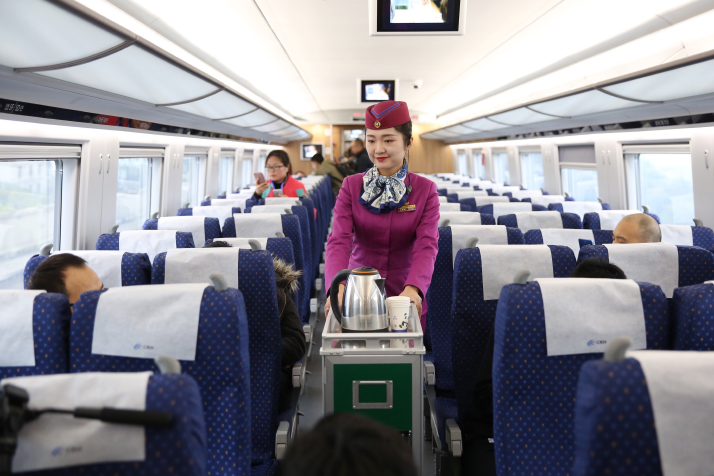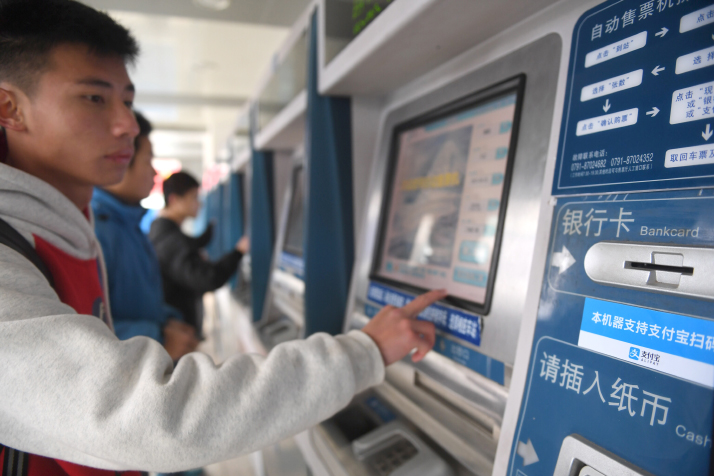|
||||||||||
| Home Nation World Business Opinion Lifestyle ChinAfrica Multimedia Columnists Documents Special Reports |
|
||||||||||
| Home Nation World Business Opinion Lifestyle ChinAfrica Multimedia Columnists Documents Special Reports |
| ChinAfrica |
| The Great Trek |
| Chinese embrace convenient modern transport to travel back to their hometowns during the Spring Festival |
| By Li Jing | VOL.10 February 2018 ·2018-02-07 |
When will you go back home for the Spring Festival? This is a question most often asked in China as the Chinese Lunar New Year approaches by people who work or study in places other than their hometowns. Zhao Jian, 26, works in a construction company in Beijing. Zhao has lived in the capital since 2009, when he first came to study at Beijing Language and Culture University, and he has been asked the same question by friends and colleagues every year for the past nine years.
Zhao's hometown is in Taiyuan, capital city of north China's Shanxi Province, which is more than 500 km west of Beijing. Eight years ago, it took him almost 10 hours of train ride to get home, a trip that now takes just three hours on the high-speed railway. "I can get on the train in the morning and have lunch with my family at home [in Taiyuan]," Zhao told ChinAfrica. "It's quite easy now."

Because of his busy work schedule, he has to work until the Spring Festival Eve, which falls on February 15 this year. However, with the convenient train schedule he's not particularly worried as he can leave Beijing after work and still be in time for a family reunion dinner at home. One thing that does worry Zhao is getting his hands on a ticket. "It is still difficult to buy a train ticket during the Spring Festival because of the large number of passengers at that time," he said, having decided to buy it online the moment the tickets are available. In 2010, the ticket website of the Railway Customer Service Center came into service, and passengers can now book tickets one month in advance.
In the past eight years, China's high-speed rail transportation has grown to 25,000 km, accounting for 66.3 percent of the world's total high-speed railways, according to data from China Railway Corp. This coverage is expected to grow as the 13th Five-Year Development Plan for Railways (2016-20), released by the National Development and Reform Commission, shows that by 2020, China's rail operation will reach 150,000 km, including 30,000 km of high-speed railway.
More choices
After China adopted the reform and opening-up policy in the late 1970s, there was a migration from the rural areas to the more developed coastal regions for work and study. During the Spring Festival, many of these people return home for family reunions, creating the world's largest temporary migration, which is commonly known as chunyun, or literally, transportation for the Spring Festival.
Being aware of the fact that securing a ticket is a bit of a lottery, Zhao has a backup plan in place. "If I cannot get a train ticket on that day, I will use an online shared car service or take a plane," he said.
With the increase in people's incomes, the options now available to get home include rail, flights and driving. China's leading travel service provider Ctrip estimated that more than 67 million passengers will travel by plane during the chunyun period this year from February 1 to March 12, and 393 million passengers will take trains.
According to a survey conducted by Ctrip, released in December 2017, 72 percent of the respondents indicated that they will go home for family reunion during the Spring Festival, with an average traveling distance of 700 km.

And the tradition of carting gifts home has also changed. "I can buy gifts online, and the gifts can be delivered to my home directly," said Zhao, who acknowledged that the best gift was still reuniting with his family.
Pain and joy
While Zhao takes the advances made in travel and gift buying in his stride, his father, Zhao Anwen marvels at the rapid development in travel.
"Compared with the time when I was young, it is really convenient traveling these days," said Zhao senior.
The 53-year-old now works in Taiyuan. When he was young, he had to travel 430 km from Taiyuan to his hometown, Xiaozi Village in Yuncheng, southwest Shanxi, every year for the Spring Festival. The trip was arduous and would take him a day to get home.
"In the 1980s when I started working in Taiyuan, it was really a headache to travel to my hometown," he told ChinAfrica. "As there was no ticket agency or online ticket booking service, I had to go to a railway station to buy tickets," he recalls, adding that the process would often mean waiting in a long queue until midnight.
The trip itself was also stressful. Owing to the poor living standards in the countryside, he would load up on family gifts. "I had to carry all the gifts, including baijiu (Chinese liquor), cakes, food supplements for the seniors, toys for children and clothes," he said. It often meant hiring a cart to transport the gifts to the train.
The more than 10 hours' ride on the train, often standing as seats were on a first-come-first-served basis, could only take Zhao senior to a place closer to his village, where he would then take two buses to his village. "Without a phone, I used to write a letter home about one month before I departed to inform my family members which train I would take. They could then figure out when I would reach the village," he said. "The moment I saw them waiting for me outside the village, all the pain of the journey disappeared. It was really an unforgettable experience."
Today, Zhao senior does not need to concern himself with train ride during the Spring Festival, as he has settled down in Taiyuan. His son now comes to him on a journey that is much more relaxed. "You can see how China has changed" he said.
New trends
According to Ctrip, this year's 40-day chunyun period will see more than 3 billion trips made across China. In addition, it also found that passengers' destinations during chunyun are more diversified, and not restricted to their hometowns. More families now choose to go sightseeing, both domestically and overseas. Statistics from the China National Tourism Administration show the number of domestic tourists during the Spring Festival period in 2017 reached 344 million, a year-on-year increase of 13.8 percent. Meanwhile, the number of Chinese outbound tourists rose to 6.15 million, up 7 percent year on year. Ctrip said these figures are likely to grow in 2018.
In addition, a reversal trend is also taking place. As young people settle down in big cities, their parents choose to join them from the rural areas for the Spring Festival family reunion. "Maybe next year, I will go to Beijing and spend the Spring Festival with my son there," said Zhao senior.
Comments to lijing@chinafrica.cn
| About Us | Contact Us | Advertise with Us | Subscribe |
| Copyright Beijing Review All rights reserved 京ICP备08005356号-5 京公网安备110102005860号 |